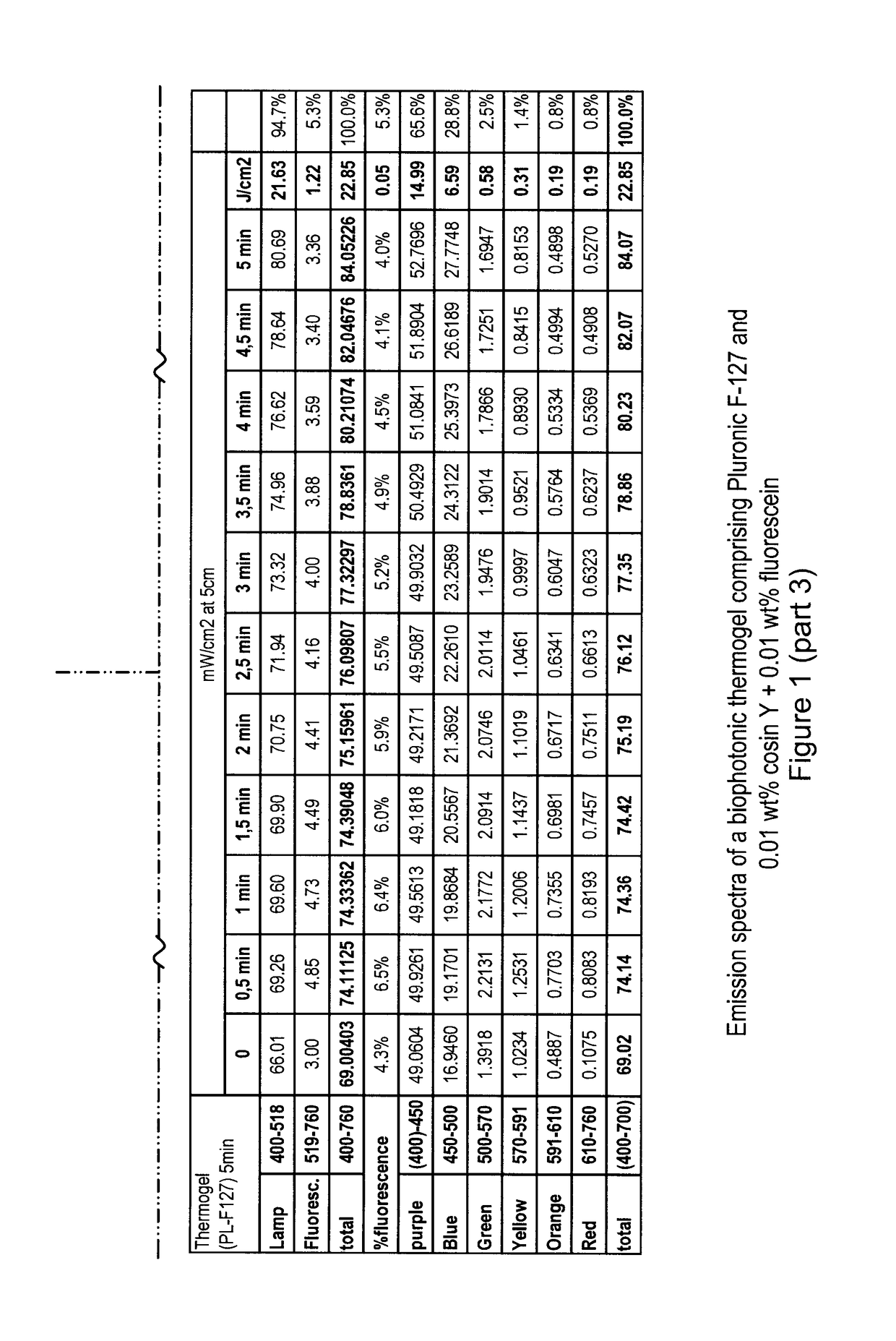Thermosetting biophotonic compositions and uses thereof
- Summary
- Abstract
- Description
- Claims
- Application Information
AI Technical Summary
Benefits of technology
Problems solved by technology
Method used
Image
Examples
example 1
on of an Exemplary Thermosetting Biophotonic Composition
[0170]A thermosetting composition was made, according to an embodiment of the present disclosure, comprising a poloxamer matrix incorporating therein chromophores. Specifically, Pluronic® F-127 was used which is a block copolymer of polyethylene glycol (PEG) and polypropylene glycol (PPG) (having a repeating unit comprising a PPG block linked to two PEG blocks), at a weight percentage which would allow it to thermoset to a cohesive biophotonic composition at temperatures between about 20° C. and 39° C., e.g. when applied to a tissue or when applied to a tissue and / or heated with a lamp.
[0171]The thermosetting (gelation) behaviour of 20% w / v and 25% w / v Pluronic F-127 solutions at different temperatures was evaluated. The solutions were prepared by dissolving Pluronic F-127 in cold de-ionised water (˜4° C.). For 20% w / v Pluronic solutions, 20 g of the Pluronic F-127 powder was dissolved in 100 mL of cold water. For 25% w / v Pluro...
example 2
ic Evaluation of the Thermosetting Biophotonic Composition of Example 1
[0177]The emission spectra of gel 3 (comprising 0.01 wt % eosin Y+0.01 wt % fluorescein) of Example 1 is shown in FIG. 1. The emitted fluorescence was measured using a SP-100 spectroradiometer (SP-100, ORB Optronix) when illuminated for 5 minutes with a light having a peak wavelength of about 400-470 nm and a power density of about 30-150 mW / cm2. As can be seen in FIG. 1, the chromophores did not fully photobleach after 10 minutes of illumination.
example 3
n of IL6 and IL8 by HaCaT Human Keratinocytes by the Thermosetting Biophotonic Composition of Example 2
[0178]The thermosetting biophotonic composition of Example 2 was evaluated for its ability to modulate inflammation, specifically cytokines IL6 and IL8. HaCaT human keratinocyte cells were used as an accepted in vitro model for assessing modulation of these inflammatory cytokines. Excessive, uncontrolled inflammation is observed in many skin conditions as well as in wounds, and can be detrimental to a host such as by impairing wound healing processes. Therefore a down regulation of IL6 and IL8 secretion may be beneficial in wound healing as well as alleviating other conditions, such as eczema and psoriasis.
[0179]A non-toxic concentration of IFNγ was used to modulate the secretion of IL6 and IL8 by the HaCaT cells. Dexamethasone (final concentration of 5 uM) was used as a positive control (strong inhibitor of pro-inflammatory cytokine production). The potential toxic effect of light...
PUM
| Property | Measurement | Unit |
|---|---|---|
| Fraction | aaaaa | aaaaa |
| Wavelength | aaaaa | aaaaa |
| Wavelength | aaaaa | aaaaa |
Abstract
Description
Claims
Application Information
 Login to View More
Login to View More - R&D
- Intellectual Property
- Life Sciences
- Materials
- Tech Scout
- Unparalleled Data Quality
- Higher Quality Content
- 60% Fewer Hallucinations
Browse by: Latest US Patents, China's latest patents, Technical Efficacy Thesaurus, Application Domain, Technology Topic, Popular Technical Reports.
© 2025 PatSnap. All rights reserved.Legal|Privacy policy|Modern Slavery Act Transparency Statement|Sitemap|About US| Contact US: help@patsnap.com



